[VIP专享]中国美术简史
- 格式:pdf
- 大小:258.85 KB
- 文档页数:7
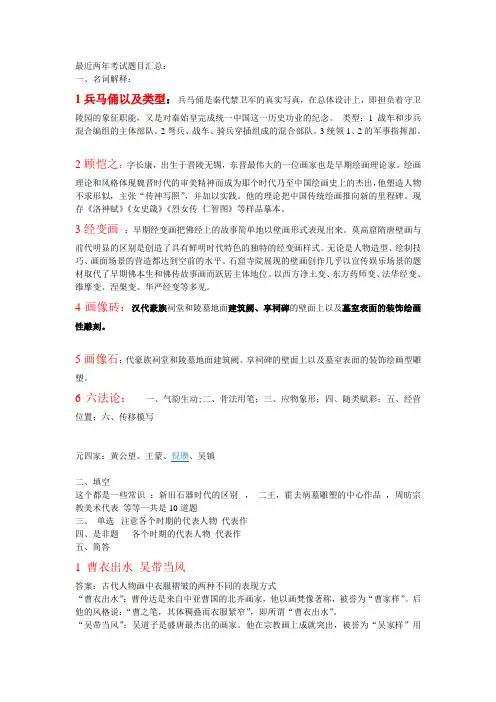
最近两年考试题目汇总:一、名词解释:1兵马俑以及类型:兵马俑是秦代禁卫军的真实写真,在总体设计上,即担负着守卫陵园的象征职能,又是对秦始皇完成统一中国这一历史功业的纪念。
类型:1战车和步兵混合编组的主体部队。
2弩兵、战车、骑兵穿插组成的混合部队。
3统领1、2的军事指挥部。
2顾恺之:字长康,出生于晋陵无锡,东晋最伟大的一位画家也是早期绘画理论家。
绘画理论和风格体现魏晋时代的审美精神而成为那个时代乃至中国绘画史上的杰出,他塑造人物不求形似,主张“传神写照”,并加以实践。
他的理论把中国传统绘画推向新的里程碑。
现存《洛神赋》《女史箴》《烈女传仁智图》等样品摹本。
3经变画:早期经变画把佛经上的故事简单地以壁画形式表现出来。
莫高窟隋唐壁画与前代明显的区别是创造了具有鲜明时代特色的独特的经变画样式。
无论是人物造型、绘制技巧、画面场景的营造都达到空前的水平。
石窟寺院展现的壁画创作几乎以宣传娱乐场景的题材取代了早期佛本生和佛传故事画而跃居主体地位。
以西方净土变、东方药师变、法华经变、维摩变、涅槃变、华严经变等多见。
4画像砖:汉代豪族祠堂和陵墓地面建筑阙、享祠碑的壁面上以及墓室表面的装饰绘画性雕刻。
5画像石:代豪族祠堂和陵墓地面建筑阙、享祠碑的壁面上以及墓室表面的装饰绘画型雕塑。
6六法论:一、气韵生动;二、骨法用笔;三、应物象形;四、随类赋彩;五、经营位置;六、传移模写二、填空这个都是一些常识:新旧石器时代的区别,二王,霍去病墓雕塑的中心作品,周昉宗教美术代表等等一共是10道题三、单选注意各个时期的代表人物代表作四、是非题各个时期的代表人物代表作五、简答1 曹衣出水吴带当风答案:古代人物画中衣服褶皱的两种不同的表现方式“曹衣出水”:曹仲达是来自中亚曹国的北齐画家,他以画梵像著称,被誉为“曹家样”。
后他的风格说:“曹之笔,其体稠叠而衣服紧窄”,即所谓“曹衣出水”。
“吴带当风”:吴道子是盛唐最杰出的画家。
他在宗教画上成就突出,被誉为“吴家样”用笔技法上,他创造出高低起伏、错落有致的“莼菜条”式的描法,加强了物象的分量感和立体感,所画人物衣带宛若迎风飘拽之状,有迎风起舞的动势,故有“吴带当风”之称。
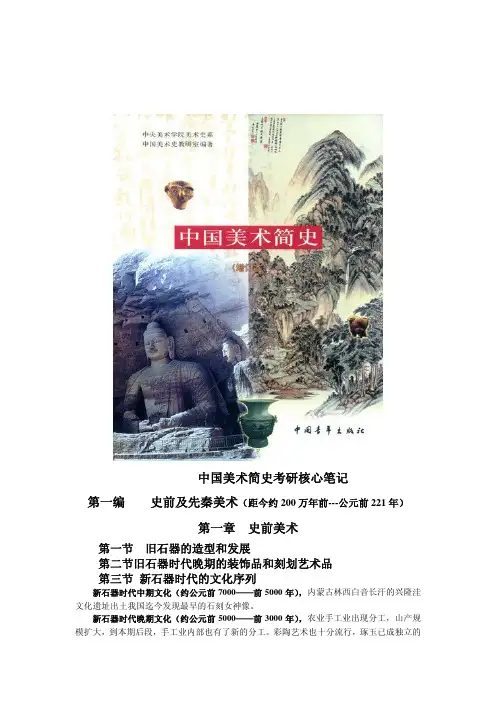
中国美术简史考研核心笔记第一编史前及先秦美术(距今约200万年前---公元前221年)第一章史前美术第一节旧石器的造型和发展第二节旧石器时代晚期的装饰品和刻划艺术品第三节新石器时代的文化序列新石器时代中期文化(约公元前7000——前5000年),内蒙古林西白音长汗的兴隆洼文化遗址出土我国迄今发现最早的石刻女神像。
新石器时代晚期文化(约公元前5000——前3000年),农业手工业出现分工,山产规模扩大,到本期后段,手工业内部也有了新的分工。
彩陶艺术也十分流行,琢玉已成独立的部门。
新石器时代末期文化(约公元前3000——前2000年),这个时代亦称龙山时代,或称铜石并用时代。
第四节 新石器时代的工艺美术陶器的发明和磨制石器的应用,并列为新石器时代的两大标志。
彩陶及分布:仰韶文化河姆渡文化龙山文化一、 陶器陶器----人类利用泥土的烧制造的实用器皿或陶艺品,是史前人类社会的重大发明。
按用途分3:饮食器,炊煮器,储藏器;按陶质分4:红、灰、白、黑;按器表装饰分4:拟形陶,彩陶,印纹陶,素陶。
彩陶文化的特征:1、型制2、纹饰:典型纹饰与作品3、手法:线描平涂综合装饰纹样分3:动物纹、植物纹、人形纹。
彩绘是制陶工艺种最成功的一种装饰艺术手法。
所谓彩陶---是指在打磨光滑的橙红色陶呸上,以天然的矿物质颜料进行描绘,用赭石和氧化锰做橙色元素,然后入窑烧制。
在橙红色的胎地上呈现出锗红、黑、白诸种颜色的美丽图案,形成纹样与器物造型的高度统一,达到装饰美化效果,这样的陶器统称彩陶。
新石器时代的彩陶纹饰距今4-7千年的新石器时代,先民的生活由游牧、游耕而转入定居为主,陶器在农业、渔猎及日常生活中占有重要的地位。
彩陶乃成为这一时期的文化象征。
其彩绘大致可分为图案、图画两类。
彩绘是陶器装饰中最卓越的手法,朴实明快,绚丽多彩的彩陶,由于地域、时间的差异,宗教习俗的不同,描绘形式的各异,在造型和风格上也各不相同。
有些条纹象征着起伏的波浪、同心扩散的水纹、绳革、丝网等。
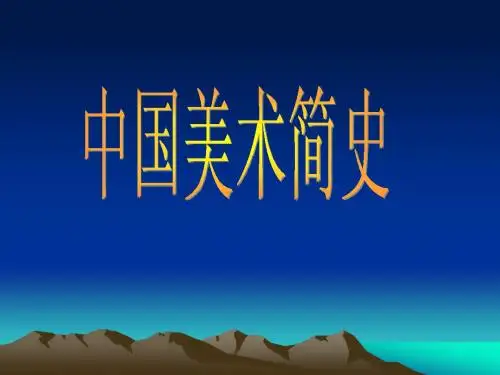
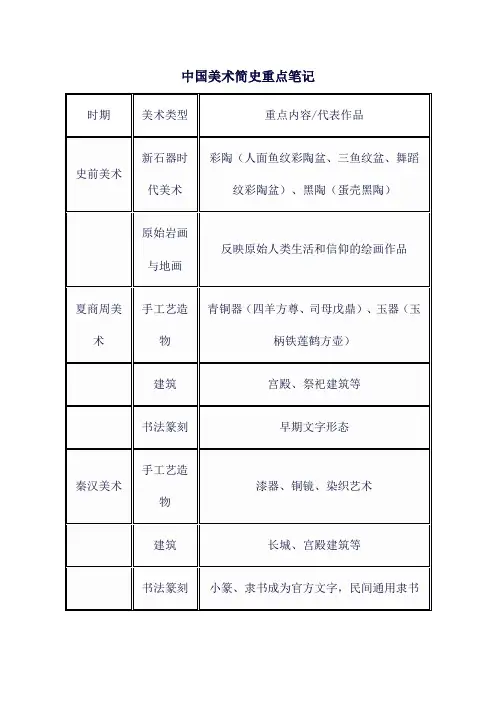
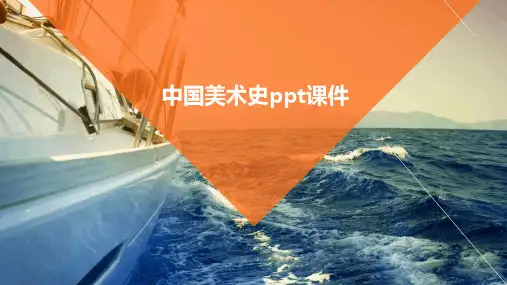
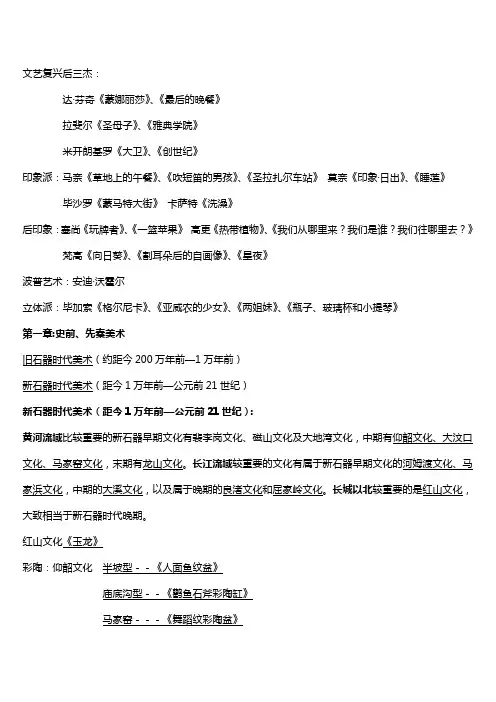
文艺复兴后三杰:达〃芬奇《蒙娜丽莎》、《最后的晚餐》拉斐尔《圣母子》、《雅典学院》米开朗基罗《大卫》、《创世纪》印象派:马奈《草地上的午餐》、《吹短笛的男孩》、《圣拉扎尔车站》莫奈《印象〃日出》、《睡莲》毕沙罗《蒙马特大街》卡萨特《洗澡》后印象:塞尚《玩牌者》、《一篮苹果》高更《热带植物》、《我们从哪里来?我们是谁?我们往哪里去?》梵高《向日葵》、《割耳朵后的自画像》、《星夜》波普艺术:安迪〃沃霍尔立体派:毕加索《格尔尼卡》、《亚威农的少女》、《两姐妹》、《瓶子、玻璃杯和小提琴》第一章:史前、先秦美术旧石器时代美术(约距今200万年前—1万年前)新石器时代美术(距今1万年前—公元前21世纪)新石器时代美术(距今1万年前—公元前21世纪):黄河流域比较重要的新石器早期文化有裴李岗文化、磁山文化及大地湾文化,中期有仰韶文化、大汶口文化、马家窑文化,末期有龙山文化。
长江流域较重要的文化有属于新石器早期文化的河姆渡文化、马家浜文化,中期的大溪文化,以及属于晚期的良渚文化和屈家岭文化。
长城以北较重要的是红山文化,大致相当于新石器时代晚期。
红山文化《玉龙》彩陶:仰韶文化半坡型--《人面鱼纹盆》庙底沟型--《鹳鱼石斧彩陶缸》马家窑---《舞蹈纹彩陶盆》岩画-内蒙古阴山岩画夏、商、周、春秋、战国美术:1、青铜器艺术龙虎纹尊(商)四羊方尊(商)2、雕塑艺术虎食人卣3、绘画艺术战国第二章:秦汉美术卜千秋墓升仙图壁画武氏祠画像石秦始皇兵马俑马踏匈奴第三章:魏晋至隋唐美术顾恺之“传神论”《女史箴图》《列女仁智图》《洛神赋图》(艺术特色)张僧“画龙点睛”(张家样)曹仲达(曹家样)、杨子华隋唐绘画:隋:展子虔《游春图》初唐:阎立本〈步辇图〉〈历代帝王图〉盛唐:吴道子(画圣)〈送子天王图〉“吴带当风”“吴家样”吴道子在用笔技法上,创造了一种波折起伏,错落有致的“莼菜条”式的描法。
用这种描法画人物的衣袖、飘带,具有迎风起舞的动势,故有“吴带当风”之称。
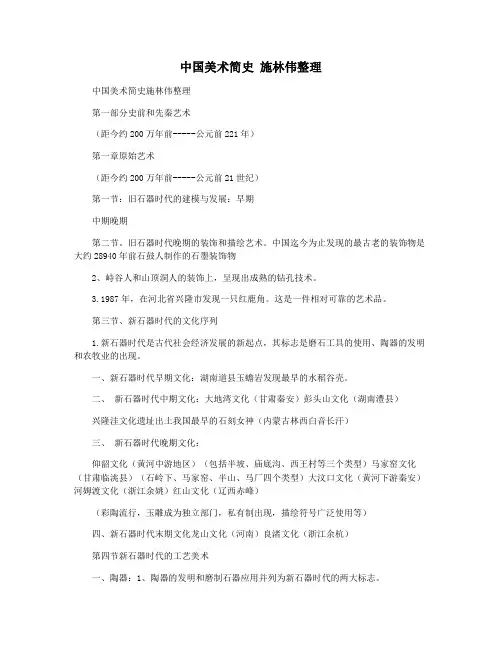
中国美术简史施林伟整理中国美术简史施林伟整理第一部分史前和先秦艺术(距今约200万年前-----公元前221年)第一章原始艺术(距今约200万年前-----公元前21世纪)第一节:旧石器时代的建模与发展:早期中期晚期第二节。
旧石器时代晚期的装饰和描绘艺术。
中国迄今为止发现的最古老的装饰物是大约28940年前石鼓人制作的石墨装饰物2、峙谷人和山顶洞人的装饰上,呈现出成熟的钻孔技术。
3.1987年,在河北省兴隆市发现一只红鹿角。
这是一件相对可靠的艺术品。
第三节、新石器时代的文化序列1.新石器时代是古代社会经济发展的新起点,其标志是磨石工具的使用、陶器的发明和农牧业的出现。
一、新石器时代早期文化:湖南道县玉蟾岩发现最早的水稻谷壳。
二、新石器时代中期文化:大地湾文化(甘肃秦安)彭头山文化(湖南澧县)兴隆洼文化遗址出土我国最早的石刻女神(内蒙古林西白音长汗)三、新石器时代晚期文化:仰韶文化(黄河中游地区)(包括半坡、庙底沟、西王村等三个类型)马家窑文化(甘肃临洮县)(石岭下、马家窑、半山、马厂四个类型)大汶口文化(黄河下游秦安)河姆渡文化(浙江余姚)红山文化(辽西赤峰)(彩陶流行,玉雕成为独立部门,私有制出现,描绘符号广泛使用等)四、新石器时代末期文化龙山文化(河南)良渚文化(浙江余杭)第四节新石器时代的工艺美术一、陶器:1、陶器的发明和磨制石器应用并列为新石器时代的两大标志。
2.陶器的用途:餐具、煮沸器和储藏器。
3、陶器的分类:按陶质分:红陶、灰陶、白陶、黑陶根据桌面装饰,可分为素陶、彩陶、印花陶和异型陶。
4.陶器的制作和装饰是同时进行的。
原始陶艺1、陶器及陶器的装饰手段早期阶段:出于实用目的,简单而粗糙,类型较少,第二个时期:既有实用价值又有作为艺术品存在的价值,采用了彩绘、纹饰等装饰手段第三个时期:种类繁多,造型丰富,镂孔、印纹等手法的应用。
2、我国新石器时代出土陶器的著名文化遗址仰韶文化(以彩陶为代表,约公元前4100-2500年)马家窑(前3300-前1800,分石岭下、马家窑、半山、马厂四个类型)、半山类型陶器代表新石器彩陶艺术的最高水平大汶口和龙山(平原陶器的杰出代表),大汶口有三个显著的特点:1。
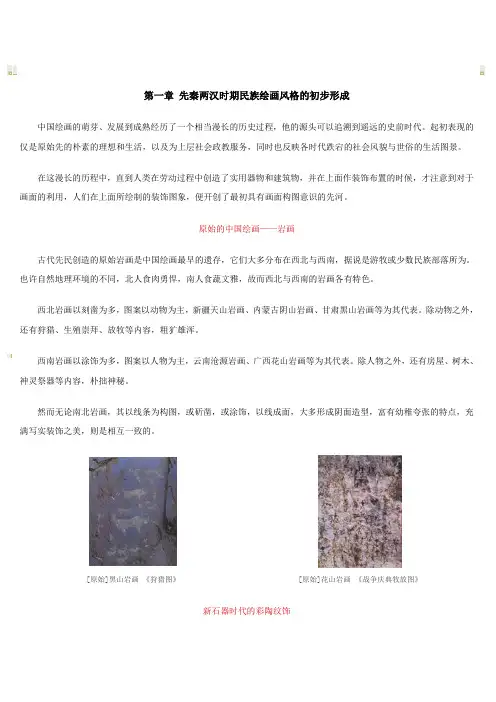
第一章先秦两汉时期民族绘画风格的初步形成中国绘画的萌芽、发展到成熟经历了一个相当漫长的历史过程,他的源头可以追溯到遥远的史前时代。
起初表现的仅是原始先的朴素的理想和生活,以及为上层社会政教服务,同时也反映各时代跌宕的社会风貌与世俗的生活图景。
在这漫长的历程中,直到人类在劳动过程中创造了实用器物和建筑物,并在上面作装饰布置的时候,才注意到对于画面的利用,人们在上面所绘制的装饰图象,便开创了最初具有画面构图意识的先河。
原始的中国绘画——岩画古代先民创造的原始岩画是中国绘画最早的遗存,它们大多分布在西北与西南,据说是游牧或少数民族部落所为。
也许自然地理环境的不同,北人食肉勇悍,南人食蔬文雅,故而西北与西南的岩画各有特色。
西北岩画以刻凿为多,图案以动物为主,新疆天山岩画、内蒙古阴山岩画、甘肃黑山岩画等为其代表。
除动物之外,还有狩猎、生殖崇拜、放牧等内容,粗犷雄浑。
西南岩画以涂饰为多,图案以人物为主,云南沧源岩画、广西花山岩画等为其代表。
除人物之外,还有房屋、树木、神灵祭器等内容,朴拙神秘。
然而无论南北岩画,其以线条为构图,或斫凿,或涂饰,以线成面,大多形成阴面造型,富有幼稚夸张的特点,充满写实装饰之美,则是相互一致的。
[原始]黑山岩画《狩猎图》[原始]花山岩画《战争庆典牧放图》新石器时代的彩陶纹饰距今4-7千年的新石器时代,先民的生活由游牧、游耕而转入定居为主,陶器在农业、渔猎及日常生活中占有重要的地位。
彩陶乃成为这一时期的文化象征。
其彩绘大致可分为图案、图画两类。
彩绘是陶器装饰中最卓越的手法,朴实明快,绚丽多彩的彩陶,由于地域、时间的差异,宗教习俗的不同,描绘形式的各异,在造型和风格上也各不相同。
有些条纹象征着起伏的波浪、同心扩散的水纹、绳革、丝网等。
红黑相同,朴素而匀称,流畅而简洁。
河南渑池的仰韶村、西安附近的半坡、甘肃的永靖,皆有大量的遗存。
图画有穿衣的人物、野禽、奔鹿、游鱼、伏龟等,形状生动,明快活泼。
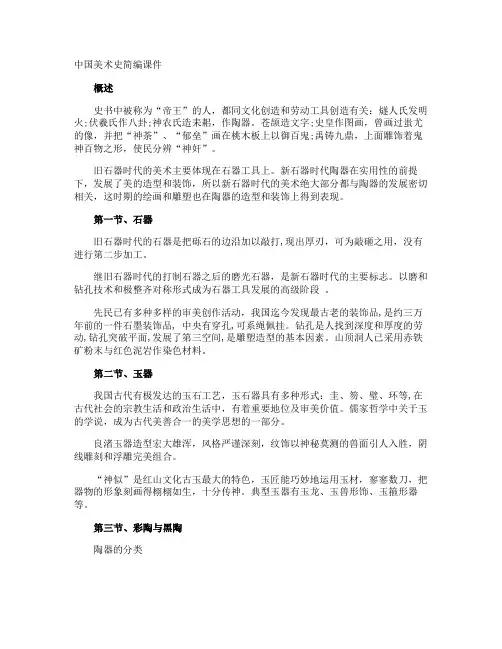
中国美术史简编课件概述史书中被称为“帝王”的人,都同文化创造和劳动工具创造有关:燧人氏发明火;伏羲氏作八卦;神农氏造耒耜,作陶器。
苍颉造文字;史皇作图画,曾画过蚩尤的像,并把“神荼”、“郁垒”画在桃木板上以御百鬼;禹铸九鼎,上面雕饰着鬼神百物之形,使民分辨“神奸”。
旧石器时代的美术主要体现在石器工具上。
新石器时代陶器在实用性的前提下,发展了美的造型和装饰,所以新石器时代的美术绝大部分都与陶器的发展密切相关,这时期的绘画和雕塑也在陶器的造型和装饰上得到表现。
第一节、石器旧石器时代的石器是把砾石的边沿加以敲打,现出厚刃,可为敲砸之用,没有进行第二步加工。
继旧石器时代的打制石器之后的磨光石器,是新石器时代的主要标志。
以磨和钻孔技术和极整齐对称形式成为石器工具发展的高级阶段。
先民已有多种多样的审美创作活动,我国迄今发现最古老的装饰品,是约三万年前的一件石墨装饰品, 中央有穿孔,可系绳佩挂。
钻孔是人找到深度和厚度的劳动,钻孔突破平面,发展了第三空间,是雕塑造型的基本因素。
山顶洞人已采用赤铁矿粉末与红色泥岩作染色材料。
第二节、玉器我国古代有极发达的玉石工艺,玉石器具有多种形式:圭、笏、璧、环等,在古代社会的宗教生活和政治生活中,有着重要地位及审美价值。
儒家哲学中关于玉的学说,成为古代美善合一的美学思想的一部分。
良渚玉器造型宏大雄浑,风格严谨深刻,纹饰以神秘莫测的兽面引人入胜,阴线雕刻和浮雕完美组合。
“神似”是红山文化古玉最大的特色,玉匠能巧妙地运用玉材,寥寥数刀,把器物的形象刻画得栩栩如生,十分传神。
典型玉器有玉龙、玉兽形饰、玉箍形器等。
第三节、彩陶与黑陶陶器的分类陶器依用途可分为饮食器、炊煮器和储藏器。
其中盆、钵、碗、杯、豆、勺属饮食器;鼎、鬲、簋、釜、灶属炊煮器;壶、罐、瓶、瓮属储藏器。
如果按陶质来分有红陶、灰陶、白陶和黑陶。
如以器表装饰情况来划分,则有素陶、彩陶、印文陶和拟形陶。
装饰纹样有动物、植物和人形,但就彩陶来看,绝大部分是组合方式变化多端的几何纹样。
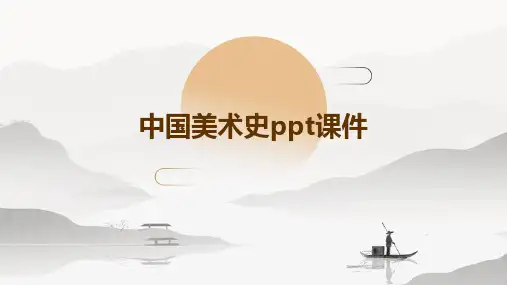
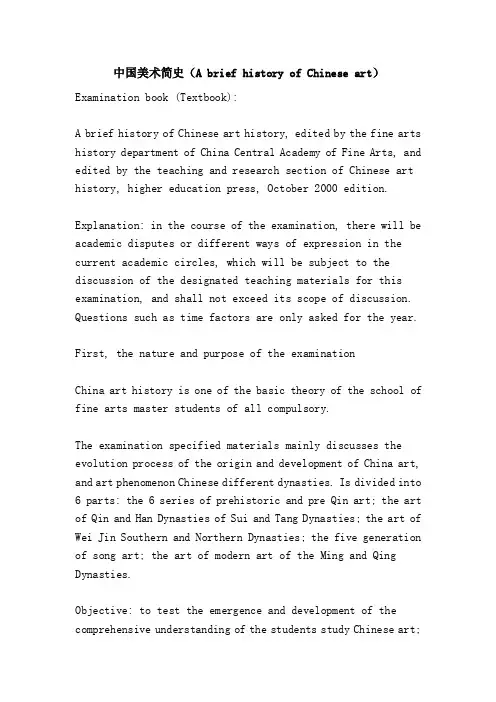
中国美术简史(A brief history of Chinese art)Examination book (Textbook):A brief history of Chinese art history, edited by the fine arts history department of China Central Academy of Fine Arts, and edited by the teaching and research section of Chinese art history, higher education press, October 2000 edition.Explanation: in the course of the examination, there will be academic disputes or different ways of expression in the current academic circles, which will be subject to the discussion of the designated teaching materials for this examination, and shall not exceed its scope of discussion. Questions such as time factors are only asked for the year.First, the nature and purpose of the examinationChina art history is one of the basic theory of the school of fine arts master students of all compulsory.The examination specified materials mainly discusses the evolution process of the origin and development of China art, and art phenomenon Chinese different dynasties. Is divided into 6 parts: the 6 series of prehistoric and pre Qin art; the art of Qin and Han Dynasties of Sui and Tang Dynasties; the art of Wei Jin Southern and Northern Dynasties; the five generation of song art; the art of modern art of the Ming and Qing Dynasties.Objective: to test the emergence and development of the comprehensive understanding of the students study Chinese art;the level of understanding of each period of art concept and representative, representative works; whether from the evolution of art development and cultural point of view, understanding Chinese art forms and means of expression.Two, assessment objectivesFirst, prehistoric and pre Qin ArtExamination objectives and requirementsThis part requires candidates from the origin of man's point of view, to understand the origin of Chinese art, understanding the characteristics of China stone age of primitive art; from Chinese civilization history perspective, understanding the Xia Shang Zhou bronze art style and ornamentation, and its present situation and its social significance, its categories of art.First, the prehistoric art section(1) examination of knowledge points;1. The art of the Old Stone Age2, the stone sculptures of the Neolithic Age3, the painting of the Neolithic Age4, the Neolithic arts and crafts(two) assessment requirements;1. The art of the Old Stone AgeRemember: the early form of art.Understanding: the origin of art.2, the stone sculptures of the Neolithic AgeRemember: pottery, clay sculpture, stone carving, jade carving characters and representative works.Understand the origin and development of pottery, clay sculpture, stone carving, jade carving.3, the painting of the Neolithic AgeRemember: characteristics and representative works of pottery design and decoration of the cultural period; murals, painting and painting characteristics and representative works.Understanding: the emergence and development of painted pottery, murals, paintings and rock paintings.4, the Neolithic arts and craftsRemember: features and construction processUnderstanding: the emergence and development of technology and architectureTwo, pre Qin art section(1) examination of knowledge points;1 bronze ware2, sculpture3, painting4, technology and architecture(two) assessment requirements;1 bronze wareRemember: Xia Shang Zhou, spring and autumn and the Warring States Bronze characteristics and representative works.Understanding: the emergence and development of bronze ware.2, sculptureRemember: bronze sculpture, Shi Yu sculpture, pottery, lacquer carving characteristics and representative works.Understand the origin and development of bronze sculpture, Shi Yu sculpture, pottery, lacquer carving.3, paintingRemember: the murals, paintings, decorative painting process and characteristics of representative works.Understand the origin and development of murals, paintings, decorative painting.4, technology and architectureUnderstanding: evolution and development of calligraphy by generations.4, technology and architectureRemember: technology and architectural characteristics and representative works.Understanding: the evolution and development of technology and architecture.Fourth and Five Dynasties Song and Yuan Dynasty Fine ArtsExamination objectives and requirementsThis part from the period of social reform, require candidates to economic development, the rise of Confucianism, from the late North South confrontation state of society's point of view, mainly to understand the development of this period palace painting, landscape painting, aesthetic pursuit of literati painting and calligraphy, and other art phenomenon.(1) examination of knowledge points;1, painting2, calligraphy3 architecture and sculpture4, arts and crafts(two) assessment requirements;1, paintingRemember: the main artist in every period of the art style and representative works of painting works.Understanding: the evolution and development of painting art; painting theory.2, calligraphyRemember: the calligrapher's art style and their representative works.Understanding: the evolution and development of calligraphy.3 architecture and sculptureRemember: Architecture and sculpture art features of each period and representative works.Understanding: evolution and development of architecture and sculpture.4, arts and craftsRemember: each period of all kinds of Arts and crafts art characteristics and representative works.Understanding: the evolution and development of Arts and crafts.Fifth series Ming and Qing artExamination objectives and requirementsThis part requires candidates to inherit the culture of Song Dynasty from the Ming Dynasty and the new cultural perspective, understanding from the Ming Dynasty to the development of art schools varied, the formation and development of understanding of literati painting and literati painting standard, and other art phenomenon.(1) examination of knowledge points;1, painting2, calligraphy3 architecture and sculpture4, arts and crafts(two) assessment requirements;1, paintingRemember: the main artist in every period of the art style and representative works of painting works.Understanding: the evolution and development of painting art; painting theory.2, calligraphyRemember: the calligrapher's art style and their representative works.Understanding: the evolution and development of calligraphy.3 architecture and sculptureRemember: Architecture and sculpture art features of each period and representative works.Understanding: evolution and development of architecture and sculpture4, arts and craftsRemember: each period of all kinds of Arts and crafts art characteristics and representative works.Understanding: the evolution and development of Arts and crafts.Sixth Series modern artExamination objectives and requirementsThis part requires candidates from western culture and traditional cultural development angle, this period mainly China painting and Western painting evolution and development situation, and its artistic characteristics.(1) examination of knowledge points;1, Chinese painting2, Western painting(two) assessment requirements;1, Chinese paintingRemember: art style and representative works of painter China painting in different periods.Understanding: the evolution and development of painting art.2, Western paintingRemember: the western painting painter's artistic style andtheir representative works.Understanding: the evolution and development of painting art.Three, examples of questionsThere are four types of questions in this paper: fill in the blanks, choose single items, answer questions and discuss questions. Examples are as follows:The ancients said: fill in the blanks "painting lines such as silk", "spring floating cloud, water line".Individual choice: 1.The first Chinese royal painting organization was founded in ().A. B. C. D. in the Ming Dynasty of Qin Dynasty of Tang Dynasty in Song DynastyAnswer: the artistic features of the Qin terracotta warriors.This paper deals with the emergence and evolution of Chinese literati painting.Examination outline of foreign art historyExamination book (Textbook):A brief history of foreign art (Revised Edition), Departmentof art history, China Central Academy of Fine Arts, edited by the teaching and research section of foreign art history, higher education press, April 1998, second edition.Explanation: in the course of the examination, there will be academic disputes or different ways of expression in the current academic circles, which will be subject to the discussion of the designated teaching materials for this examination, and shall not exceed its scope of discussion. Questions such as time factors are only asked for the year.First, the nature and purpose of the examinationForeign art history is one of the basic theories of our school master of fine arts students of all compulsory.This examination specifies the main materials for a systematic exposition of the arts, developments and their interactions in the world, and introduces the major artists and artistic phenomena in various regions and countries of the world. Is divided into eight chapters: the original, ancient art; the European medieval art; art of the Renaissance; the 17 in Europe in eighteenth Century, the nineteenth Century European and American art; art; the art of twentieth Century; the Asian art; the art of ancient Africa and Latin America.Objective: to test the emergence and development of the comprehensive understanding of students visit the western countries and the area of art; the level of understanding of the major trends or genre concepts and representatives, works of art development and evolution; whether from the angle ofculture, understanding the traditional and modern art forms and means of expression.Two, assessment objectivesChapter 1 primitive and ancient art(1) examination purposes and requirementsThis chapter mainly examines the origin of human fine arts civilization, including the ancient Mesopotamia art, ancient Egyptian art and ancient Greek, Rome art, and the three interrelated. These are all the basis for understanding the future art development and the premise of learning the whole course. It is one of the key and difficult parts of this exam.(two) examination knowledge points;1. ancient Mesopotamia art;2. ancient Egyptian art;3. ancient Greek and Rome art.(three) assessment requirements;1. ancient Mesopotamia art;Mastery: (1) Fine Arts in Babylon; (2) Sumerian Acard arts and crafts.Understanding: (1) the history of art development in ancient Mesopotamia; (2) why is the civilization of ancient Mesopotamia in the world one of the four major civilizations in the world?.2. ancient Egyptian art;Mastery: (1) the characteristics of ancient Egyptian art; (2) ancient Egyptian art in the ancient kingdom.Understanding: (1) ancient Egyptian art in the Middle Kingdom;(2) ancient Egyptian art in the period of the new kingdom; (3) the influence of ancient Egyptian sculpture on ancient Greek sculpture.3. ancient Greek and Rome art.Master: (1) the formation of the historical and cultural background; (2) the ancient Greek art in the Archaic period of construction; (3) the ancient Greek classical period of architecture and art sculptor; (4) the unique achievement of ancient Rome art.Understanding: (1) sculpture of ancient Greek art in ancient times;(2) ancient Greek Hellenistic art; (3) ancient Rome art architecture; (4) ancient Rome art sculpture.The second chapter, European Medieval Art(1) examination purposes and requirementsThe characteristics, this chapter mainly examine medieval Christianity art of the Carolingian revival of the arts, Rome art and Gothic art etc..(two) examination knowledge points;1. Byzantine art;2. barbarian art and Carolingian renaissance;3. Rome art;4. Gothic art.(three) assessment requirements;1. Byzantine art;Byzantine art.Understanding: the meaning of golden byzantium.2. barbarian art and Carolingian renaissance;Master: the Carolingian renaissance.Understand: barbarian art.3. Rome art;Understanding: the characteristics of Rome art.4. Gothic art.Understanding: the characteristics of Gothic art.The third chapter, European Renaissance Art(1) examination purposes and requirementsThis chapter mainly examine the European Renaissance Italy, the Netherlands, Germany, Spain and France, as well as the influence of art, the countries of the European Renaissance art and Renaissance origin and other aspects, is the focus of the examination, the difficult part of.(two) examination knowledge points;1. Renaissance art in Italy;2. of the art of the renaissance;3. German Renaissance art;4. Spanish Renaissance art;5. French Renaissance art.(three) examination requirements, art encyclopedia, Art Library1. Renaissance art in Italy;Mastery: (1) art of the Renaissance period in Italy; (2) Venice painting school.Understanding: (1) the humanistic background of Renaissance art in Italy; (2) art in the early Renaissance of Italy.2. of the art of the renaissance;Master: the Renaissance painter Bruegel.Understand: the Renaissance artists and other art phenomenon.3. German Renaissance art;Master: German Renaissance artist duerer.Understanding: other German art phenomena and artists during the renaissance.4. Spanish Renaissance art;Mastery: Spanish Renaissance art prodigy Greco.Understanding: (1) Spanish art in 14 and fifteenth Century; (2) Spanish art in sixteenth Century; (3) Spanish Renaissance architecture and sculpture.5, French Renaissance art.Mastery: Fontainebleau painting school.Understanding: other artists and artistic phenomena during the Renaissance in france.The fourth chapter: European art in 17 and eighteenth Century(1) examination purposes and requirementsThis chapter mainly inspects 17 in Europe in eighteenth Century, Italy, Flanders, Holland, Spain and France Art development, Baroque art style features and other aspects of the content, is the focus of the examination, the difficult part of.(two) examination knowledge points;1.17 and eighteenth Century, Italy art;The 2.17 century Flemish art;Holland art in the 3.17 century;Spanish art in 4.17 and eighteenth Century;French art in 5.17 and eighteenth Century.(three) assessment requirements;1.17 and eighteenth Century, Italy art;Mastery: (1) art of Italy Academy of art in seventeenth Century;(2) Italy artist Caravaggio in seventeenth Century; (3) Baroque art formation and development.Understanding: (1) local art school of Italy in seventeenth Century; (2) art in Italy in eighteenth Century.The 2.17 century Flemish art;Mastery: the art of Lubensi.Understand other artists: seventeenth Century FlandersHolland art in the 3.17 century;Mastery: the art of the realist Maestro Rembrandt.Understanding: (1) genius portrait painter Hals; (2) colorful Holland school painting art; (3) the artistic achievements of Holland landscape painting.Spanish art in 4.17 and eighteenth Century;Mastery: (1) the truth painter drew your attention; (2) European romantic pioneer Goya.Understanding: (1) Rivera and Su Balaam; (2) Spanish art in the second half of the seventeenth Century; (3) architecture and sculpture in Spain in 17 and eighteenth Century.French art in 5.17 and eighteenth Century.Mastery: French painting in 17 and eighteenth Century.Understanding: French sculpture in 17 and eighteenth Century.The fifth chapter, European and American Art in nineteenth Century(1) learning objectives and requirementsThe main assessment of this chapter, the development of France, Britain, Russia and the United States in nineteenth Century, the phenomenon of art and law, as well as the origin of modern art and other aspects, is one of the key parts of this examination.(two) examination knowledge points;1. neo classical art in france;2. French romantic art;3. French Critical Realism art;4. French Impressionism, new Impressionism and post Impressionist art;British Art in 5.18 and nineteenth Century;American Art in the 6.19 century;7.18, 19 Russian art.(three) assessment requirements;1. neo classical art in france;Mastery: (1) artist David and Angell.Understanding: (1) French neo classical art; other artists.2. French romantic art;Master: (1) by Gericault and Delacroix.Understanding: (1) French romantic art; other artists.3. French Critical Realism art;Master: (1) the realist painter Courbet; (2) Coehlo and Miller (3) Barbizon sculptor Luo Dan (4).Understand the reason: (1) the rise of realism; (2) the Barbizon seven gentlemen4. French Impressionism, new Impressionism and post Impressionist art;Mastery: (1) French Impressionist; (2) new Impressionist in France; (3) post Impressionist artists in france.Understanding: (1) the social and cultural background of the rise of impressionism; (2) the great influence of Impressionistart.British Art in 5.18 and nineteenth Century;Master: (1) British landscape painting; (2) a.Understanding: (1) British Art in eighteenth Century; (2) British Romantic art; (3) Impressionist london.American Art in the 6.19 century;Mastery: American Art in the second half of the nineteenth Century.Understanding: (1) American Art in colonial period before and after the war of independence; (2) Hudson River Painting school.7.18, 19 Russian art.Mastery: Russian tour school.Understanding: (1) Russian art in eighteenth Century; (2) Russian art in the first half of the nineteenth Century; (3) Russian art in the second half of the nineteenth Century.The sixth chapter, twentieth Century Art(1) examination purposes and requirementsThis chapter mainly appraisal of western modern art phenomenon,and the representative figures such as Picasso, Duchamp and other artists, they in the development of western modern art in the status and role of the content, is one of the key parts of the exam.(two) examination knowledge points;1. modern western art;2. Soviet art.(three) assessment requirements;1. modern western art;Master: (1) Fauvism and Matisse; (2) Picasso and cubism. (3) dada and Duchamp.Understanding: (1) western modern art before World War II; (2) western modern art after World War II; (3) western modern sculpture and architecture.2. Soviet art.Understanding: (1) Soviet art before and after 20s; (2) Soviet art in 30s; (3) Soviet art in 60s.The seventh chapter, Asian Art(1) learning objectives and requirementsThis chapter mainly inspects the ancient India art and the Japanese modern fine arts development and so on.(two) examination knowledge points;1. India art;2. Japanese art.(three) assessment requirements;1. India art;Mastery: India classical art.Understanding: (1) India early art; (2) India (3) India medieval art; modern art.2. Japanese art.Mastery: the age of secular art.Understanding: (1) the era of pre history art; (2) Buddhist art era.Three, examples of questionsThis course examination paper contains five types of questions: fill in the blanks, select questions, explain the noun, answer questions and discuss the questions.Examples are as follows:Fill in the blanks:The earliest form of human art came into being.Two, individual choice:The following is the pre Raphaelite artist belongs to ().A. Maurice,B., Cezanne,C., Duchamp,D., PicassoThree. NOUN explanation:Beast pieFour, use the:The foundation and condition of Renaissance art are briefly introduced.Five, discuss:The research fields and research methods of post-modern art are discussed.。
1、彩陶:是指在橙红色的器壁上用赤铁矿与氧化锰颜料绘制图案,烧成呈黑色或褐色,具有热烈明快的格调的陶器.2、画像石(砖):是指汉豪族祠堂和陵墓地面建筑、享祠、碑的壁面上以及墓室表面的装饰绘画性雕刻.5、南宋四家:以李唐、刘松年、马远、夏圭为代表的院体山水画,开创了山水画艺术的新风格.他们四人被称为.6、“三远”:郭熙的山水画论透视原则和空间处理的重要法则即深、高、平.12、海派:上海画派的主要画家任熊、任薰、任颐、虚谷、等人,他们既学习传统,而又不拘于传统,有所革新.24、“南宋四大家”:李唐、刘松年、马远、夏圭被称为“南宋四大家”。
以四人为代表的院体山水画开创了南宋山水画艺术的新风格。
如果说北宋山水画艺术以雄浑、辽阔、崇高胜,南宋山水画则以秀明、工致、优美胜。
25、〈〈清明上河图》:是具有重要历史价值和艺术价值的风俗画长卷,作者北宋末期优秀的人物风俗画家张择端。
作者通过清明节日北宋都城汴梁和以虹桥为中心的汴河两岸各阶层人物活动情景的描绘,反映了这一历史时期社会生活的一些侧面。
这幅作品不愧为我国古代绘画中最杰出的作品之一。
26、文人画:是指封建时代文人士大夫创作的鲜明反映他们生活理想和审美情趣的具有独特形式的绘画。
文人画作为一种艺术流派的形成是在北宋后期,元代逐趋成熟,并成为中国封建后期画坛的中坚。
27、元四家:黄公望、王蒙、倪瓒、吴镇是元代最具代表性的文人画家,世称元四家。
四人绘画具有中国文人画的共同特点:强调浑厚的文学趣味,突出强调笔墨,以书入画,画上题字作诗;又各具特色:黄画空灵潇洒、王画苍茫浑厚、倪画简淡疏荒、吴画沉郁湿润。
42、明四家(吴门四家):沈周与文征明同为吴门画派的开派大家,而唐寅、仇英是“吴派”的友军。
在画史上一般把他们四人称为“吴门四家”或“明四家”。
他们的出现,不仅打破了“院体”和“浙派”垄断画坛的局面,而且标志着明代绘画独立面貌的形成,进一步完善了文人画的艺术形式。
4、何谓“南宋四家”,并分别叙述其艺术特点.李唐、山石用“大斧劈皴”笔势雄阔,畅快淋漓,构图采取近景以角,起“开派”的作用.刘松年、画风工整,写茂林修竹, 山明水秀之景.马远、画面简陋,全景不多.山石用大斧劈兼水墨皴,也兼用钉头鼠尾的皴法,笔势锋利严谨,方便有力.画树多用焦墨,秀拔多姿.夏圭:在用笔上好用秃笔,点笔和夹笔,墨线气势起伏,落笔速度大而轻,尾端呈现尖状线条,富有变化15、比较北宋山水画与南宋山水画在构图以及空间处理上的北宋山水画以雄壮、辽阔、崇高胜.南宋山水画秀丽、工整、优美胜,两美并峙,各有千秋.36、简要论述元四家的生平、作品及艺术成就.黄公望〈〈富春山居图》、王蒙〈〈夏山高隐》、倪瓒〈〈松林亭子》吴镇〈〈松泉图》.表现1强调绘画的文学化,使作品的文学趣味得到进一步加强.2与文学趣味一致,并且具体体现这一趣味,构成元画特色的是对笔墨的突出强调和以书入画.3与相辅而行,画上题字作诗蔚然成风.18、元四家”是指哪四位画家?他们在艺术上共同的特点是什么?答:元四家是:黄公望、吴镇、倪瓒、王蒙。
中国美术史简述中国美术史经典资料晚期马家窑文化(马厂、半山、马家窑)二、彩陶文化的特征:1、型制2、纹饰:典型纹饰与作品3、手法:线描平涂综合陶器----人类利用泥土的烧制造的实用器皿或陶艺品,是史前人类社会的重大发明。
按用途分3:饮食器,炊煮器,储藏器;按陶质分4:红、灰、白、黑;按器表装饰分4:拟形陶,彩陶,印纹陶,素陶装饰纹样分3:动物纹、植物纹、人形纹。
山大本课题拟形陶----指将器外形做成某种事物形象的陶器,如狗形陶,鹰形陶等。
就功能说,它具有同类器皿的实用功能;从外表看,它又是一种史前雕塑。
彩陶----指器表带有彩绘纹样装饰的史前陶器。
多以红黑白黄赭等颜色绘成纹样,色彩沉稳浑朴,纹样造型概括简练,并具有较强的主观抽象性。
有几何、植物、动物、人物纹样,是史前美术品中装饰最精美,内容最丰富,艺术成就最高的艺术形式。
山大本科题陶塑的创作手法分为:模仿性、幻想性、抽象性山大本科题(一)青铜器概述青铜器类别“礼器、乐器、兵器、工具器、车马器”功用及其文化内涵青铜器的范围非常广泛,从功能上大体可分为四类:(1)礼器:商周时期,一些日用青铜器由于用作祭祀和典礼时的陈设而被赋于特殊意义,成为青铜礼器。
如鼎、鬲、尊等。
(三)战国帛画《人物龙凤帛画》画中人物为一宽袖长裙,合掌侧立的上流社会的女性形象。
其上方画一展翅扬尾的凤鸟和一只张举双足,身姿劲健,尾部卷曲的龙。
所表现的是此女子的“灵魂”在被想像为具有神异力量的龙、凤引导下,升往仙境的情景。
画面上墨笔线条运转有节奏韵律感,黑白块的对比,点、线、面结合,使形象既有一定的重量感而又生意盎然。
理想化的凤鸟形象,是综合了自然界的雉、孔雀等羽毛华丽的鸟类特点创造而成,并赋予作为神灵的凤鸟形象以雄健奔放,轩昂非凡的气势。
《人物御龙帛画》画中是一位头戴高冠,身穿长袍,一手握剑,一手拉缰,驾龙升天的中年男子形象内容与上一《人物龙凤帛画》相仿,形式也近似,帛画,标志着中国古代绘画的独特风格早在战国时代已经形成,是中国画发展史上的重要里程碑。
中国美术史复习资料来源:刘凡铭的日志中国美术史新石器时代(雕塑)红山文化陶塑与泥塑女神像出土,是我国20世纪80年代初重要的美术考古新发现之一。
我国迄今为止发现最古老的圆雕石刻,内蒙古林西县白音长汗兴隆文化遗址出土的石刻女神。
河南濮阳溪水坡仰韶文化45号墓,用蚌壳摆塑龙、虎形象,这是中国墓室壁画开端,是我国目前所知年代最早、造型最大的龙图形,被誉为“中华第一龙”。
商(青铜器)司母戊方鼎、四羊方尊(形制凝重结实、纹饰繁丽雄奇)(建筑)商代重要建筑物外形由夯土台、墙体和屋顶三部分构成;建筑布局以大型宗庙或宫殿为中心,主要用纵向轴线构成整体性的建筑群落。
奠定中国建筑基本特征。
陕西岐山周遗址,是我国已知最早最严整的四合院实体。
(雕塑)玉石雕刻周(青铜器)西周毛公鼎铭文,最长的青铜器铭文。
秦(雕塑)秦始皇陵“世界第八大奇迹”汉(雕塑)跽坐姿是我国现存最古老的大型石刻,堪称我国古代园林景观雕塑的第一座丰碑。
霍去病墓石刻——马踏匈奴,是主体性与完美性统一的典范,是西汉纪念碑雕刻划时代成就的典范。
画像石是雕塑着不同画面,用于构筑墓室、石棺、享祠或石阙的建筑石材。
根据现有资料,画像石萌发于西汉武帝时期;新莽时期有所发展。
东汉时期,画像石分布地区扩大,形成四个中心区:一、山东、苏北、皖北区;二、豫南、鄂北区;三、陕北、晋西北区;四、四川地区。
此外,北京、河北、浙江海宁等地也有零星发现。
画像砖是秦汉时代的一种建筑装饰构件,与画像石类似。
其制作工艺是将加工好的泥坯放入木模中制成砖坯,待半干后去掉木模,用刻有图案内容的印模印出各种图像和图案,大型图案用几个印模多次压印,部分图像用利器刻画而成。
有空心砖和实心砖两种。
东汉是画像砖艺术的鼎盛时期,产品数量、制作水平都特别突出。
盛行于中原、西南和江南的广大地区,尤以河南和四川两省出土最多。
三国(青铜器)春秋莲鹤方壶(自由舒展、活泼灵动)魏晋南北朝(壁画)在甘肃嘉峪关和吐鲁番地区出土的《地主庄园图》已知最早的纸本绘画。
(建筑)河南登封嵩岳寺塔,是中国现存最早的转塔。
(绘画)曹不兴,记载中最早的佛像画家,亦是有记载的第一位画家。
顾恺之(有才绝、画绝、痴绝“三绝”之称)绘画注重表现人物精神风貌,尤其是眼神的描绘。
以绘画艺术的语言来着意刻画对象的心理特征与精神风貌。
“悟对通神”。
代表作品:《女史箴图》、《洛神赋图》。
《论画》、《画云台山记》(绘画创作构思性笔记)——朴素的唯物思想提出对绘画对象的要求;强调临摹中的准确再现;将画论提高到独立的理论认识高度,开创绘画理论研究领域。
陆探微创造“秀骨清像”的人物形象,清秀隽永,是对崇高玄学,重清淡的六朝士人形象的生动概括。
谢赫《画品》是古代第一部对绘画作品、作者进行品评的理论文章。
《画品》中提出了绘画的社会功能以及品评绘画的六条标准,即“六法”。
“六法“是:一、气韵生动(生动地反映人物精神状态和性格作为艺术表现的最高准则);二、骨法用笔(通过对人物外表的描绘而反映人物特征的笔法要求);三、应物象形四、随类赋彩五、经营位置(绘画艺术的造型基础);六、传移模写(绘画的临摹和复制)。
孙畅之《述画》(第一部纪传体画史著作)宗炳《画山水序》思想受玄、释、道、儒思想的影响;“卧而游之”,提出“应会感神、神超理得”的创作构思方法;把山水创作归结为“神思”。
王微《叙画》裴孝源《贞观公私画录》(现存最早的一部绘画著录)朱景玄《唐朝名画录》(中国现存最早的一部绘画断代史)张彦远《历代名画记》提出“得意”主张,指出古代绘画中存在的“疏”“密”二体的发展线索和唐以来师资南北传授系统。
具有绘画百科全书性质。
是中国第一部体例完备、史论结合、内容宏富的绘画通史著作。
其书法论著《法书要录》。
(书法)王羲之“书圣”被称作“草隶、八分、飞白、章、行备精诸体,自成一家,千变万化”。
创作出韵媚婉转的书法新风。
行草书《兰亭序》被称为“天下第一行书”。
代表作品:《快雪时晴帖》。
王献之《中秋帖》王珣《伯远帖》隋唐(壁画)阎立本《步辇图》、吴道子“画圣”(建筑)云南大理崇圣寺千寻塔,是唐代现存的最高转塔。
(绘画)“金碧山水”展子虔《游春图》、李思训《江帆楼阁图》、李昭道《明黄帝蜀图》。
张萱《虢国夫人游春图》周昉《簪花仕女图》王维“破墨”王洽“泼墨”张璪“外师造化,中得心源”薛稷(画鹤)、边鸾(画雀)、韩幹(画马)《牧马图》、韩滉《五牛图》。
(书法)褚遂良《雁塔圣教序》我国书法史上的楷书四大家分别是欧阳询、颜真卿、柳公权、赵孟頫。
欧阳询,代表作《九成宫醴泉铭》。
(笔画瘦硬、结体严谨,体现“意在笔先,文向思后”意味。
行书《梦奠帖》)颜真卿,代表作《中兴颂》。
(称其字“点如坠石,画如夏云,钩如屈金,戈如发弩。
” 行草书《祭侄文稿》、《争座位帖》)柳公权,代表作《玄秘塔碑》。
(偏重骨力,顿挫转折明确,却又遒媚得体。
时有“颜筋柳骨”之誉。
行书《蒙诏帖》)赵孟頫,代表作《玄妙观重修三门记》。
(行草《洛神赋》、《千字文》等)张旭《古诗四帖》怀素《食鱼帖》五代(绘画)周文矩《重屏会棋图》顾闳中《韩熙载夜宴图》南北画派(北——荆浩、关仝;南——董源、巨然)荆浩《笔法记》,提出“图真”、“搜妙创真”,“六要”即气、韵、思、景、笔、墨。
山水形象要“气质聚盛”,达到神形兼备。
代表作品:《匡庐图》关仝《关山行旅图》董源《潇湘图》(创造披麻皴、点子皴)巨然《万壑松林图》黄荃擅花竹翎毛,亦能画佛道、人物、山水。
所画题材多表现精谨艳丽的富贵气象以及其用于装饰宫廷的特点。
继承唐代花鸟画传流,以极细的线条勾勒配以柔丽的赋色,线色相溶,情态生动逼真。
作品《写生珍禽图》。
徐熙善画花竹、禽鱼、蔬果、草虫。
画注重“落墨”,用笔信笔抒写,略加色彩。
自谓“落笔之际,未尝以傅色晕淡细碎为功”。
用“水墨淡彩”予人以超逸清雅的感觉。
在一定程度上突破唐以来细笔填色表现奇花异鸟的格式,但其也画过赋色浓丽并带有装饰趣味的“装堂花”、“铺殿花”。
徐熙和黄荃一在宫廷,一为处士,不同的生活环境、思想情怀及不同的落笔技巧,形成面貌迥异的风格。
对后世产生深远影响,即一派为工笔写生,重于色彩,有勾勒填彩、重彩没骨渍染等技法,多属于院画体系。
另一派则注重水墨,多为粗笔写意,计有大、小写意、兼工带写的技法。
宋人谓“黄泉富贵,徐熙野逸”。
宋(壁画)北宋武宗元《朝元仙仗图》辽庆陵,迄今发现规模最大的壁画墓。
(建筑)北宋都城最重大的改变是里坊制的彻底废除。
佛宫寺释迦塔,是现存最早最大的木结构塔。
妙应寺白塔,是国内现存最大的喇嘛式塔。
独乐寺观音阁,是国内现存最早的高层木结构楼阁。
《营造法式》李诫南宋安平桥,是20世纪前中国仅存的最长桥梁。
(绘画)李公麟《五马图》(局部)梁楷(开启元明清写意人物、减笔人物画先河)《泼墨仙人图》张择端《清明上河图》郭熙《林泉高致集》阐明山水画要表现林泉之意,满足士大夫“泉石啸傲”的精神追求。
强调对真山水的观察体验,要“自即山川取之”“神于好,精于勤,饱游饫看”主张山水画家应有全面的休养。
应“所养扩充”,“所经众多”“所览淳熟”,“所取精粹。
”代表作品:《早春图》王孟希《千里江山图》南宋四家李唐(开创南宋山水画新风)《采薇图》刘松年《四景山水图》马远《踏歌图》夏圭《遥天书雁》宋徽宗赵佶《芙蓉锦鸡图》、《闰中秋月》(书法)宋四家(苏轼、黄庭坚,米芾,蔡襄)代表作品:苏轼《黄州寒食帖》;黄庭坚《廉颇蔺相如列传》;米芾《蜀素帖》;蔡襄《万安桥记》金(建筑)卢沟桥,是中国北方目前最古老的大型联拱桥。
(绘画)张瑀《文姬归汉图》赵霖《昭陵六骏图》、(局部)元(壁画)何澄《归庄图》刘贯道《元世祖出猎图》王绎(著有《写像秘诀》,主张肖像画应在对方“叫嚣谈话之间”发现其“真性情”,反对对方“正襟危坐泥塑像”的方法。
)《杨竹西像》(建筑)《元代画塑记》记录元代宫廷艺术家从事雕塑、画像所需工料准则的书。
(绘画)赵孟頫(与欧,颜,柳并称楷书四大家)赵孟頫艺术主张标榜“古意”,谓“若无古意,虽工无益”。
引晋唐为法鉴,提倡继承唐与北宋绘画,重视神韵,追求清雅朴素的画风。
反对宋代院画过分追求形似与纤巧,确立了文人画在画坛上成为正规画的地位。
以文人画家为主角,以建构文人画图式为主题的绘画新时代,拉开了序幕。
绘画从工艳琐细之风转向质朴自然。
代表作品:《鹊华秋色图》、《千字文》。
元四家(黄公望,吴镇,倪瓒,王蒙)他们的山水重于笔墨,讲求风格,但仍有一定山水根据。
通过山水抒发一定理想,并题跋诗文加以阐述。
形式上重水墨,或稍加淡色浅绛,形成不同风貌。
但情调多流于伤感、淡泊、孤寂,反映了时代动乱中无可奈何的情绪。
在艺术功能上标榜“写胸中逸气”、“自娱”而不趋附社会审美爱好。
对明代江浙地区文人画发展有着巨大影响。
代表作品:黄公望《富春山居图》(著有《写山水诀》);吴镇《渔乐图》;倪瓒《渔庄秋霁图》;王蒙《青卞隐居图》。
明(版画)徽派版画风格精细秀美,多线纹柔细,人物修长,表情似笑非笑,布景兼及室内外,细节刻画繁密精丽。
代表人物:丁云鹏《程氏墨苑》。
《顾氏画谱》和《集雅斋画谱》堪称明代画谱之双绝。
叶子版画代表人物:陈洪绶《水浒叶子》(人物形象面容奇古,形体伟岸,衣纹排叠遒劲,出神入化,设色水石并用,以艳衬雅,由擅“易圆以方,易整以散”的装饰手法,具有丰富想象力和超乎时辈装饰意匠。
开辟“宁拙勿巧、宁丑勿媚”的艺术道路,造型夸张变幻,饶有装饰意趣,笔法遒劲,设色古雅。
与崔子忠《云中玉女图》并称南陈北崔。
(建筑)明清建筑佛塔三种形式:①楼阁式砖塔②元式喇叭塔③金刚宝座式塔(绘画)浙派(吴伟、戴进)宫廷花鸟画家(院体):边景昭、孙隆、林良、吕纪。
吴门画派(沈周,文徵明,唐寅,仇英)代表作品:沈周《庐山高图》;文徵明《古木寒泉图》;唐寅《江南农事图》;仇英《桃源仙境图》白阳青藤陈淳,号白阳山水造型精当,严于剪裁,题材花木,意境安适宁静,笔墨自由如意,被誉为“一花半叶,淡墨欹毫,疏斜历乱之致,咄咄逼真。
”代表作品《秋葵图》徐渭,号天池青藤以狂划般的笔法纵情挥洒,泼墨淋漓,在“似与不似间之间”的花木形象中,着眼于生韵的体现,同时发抒“英雄失路,托足无门”的悲愤与历劫不磨的旺盛生命力。
所画虽为花草瓜果,却具有磅礴的气势和雄肆豪放的格调,由此徐渭把中国写意画推向了能够强烈抒写内心情感的极高境界,把在生宣纸上充分发挥并随意控制笔墨的表现力,提高到前所未有的水平,成为中国写意花鸟画代表作品:《墨葡萄图》波臣派——曾鲸(创墨骨画法即以淡墨钩定轮廓五官,施墨略染后,再赋色彩)《王时敏像》华亭山水派——董其昌号思白。
对文人山水画进一步提纯绘画语言,即把中国画的笔墨语言从绘画的综合因素中突出出来,不再仅仅作为营造图像的手段,而成为绘画表现的重要目的。
使笔墨的组合成为单独的审美客体,是笔墨的精妙与趣味称为画面的中心,建立具有抽象形式美感的画面结构。